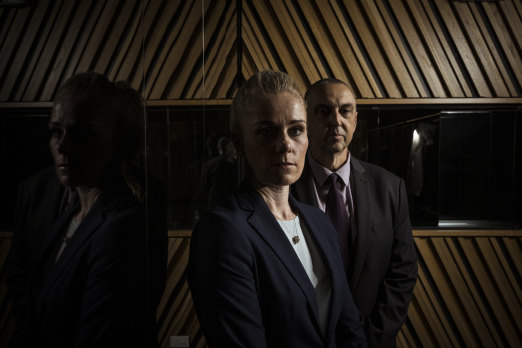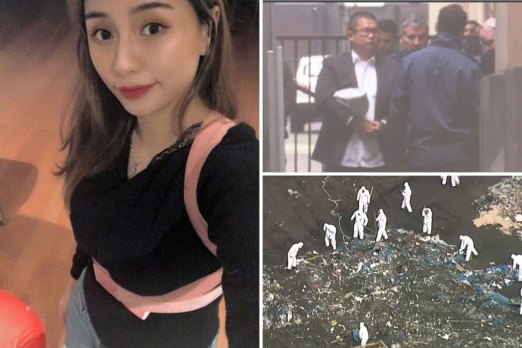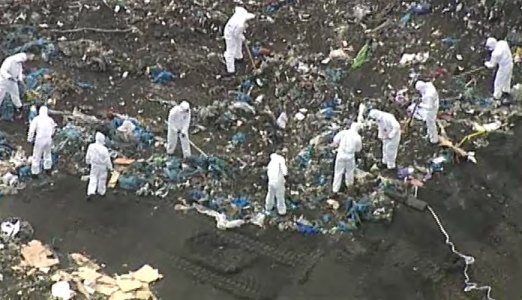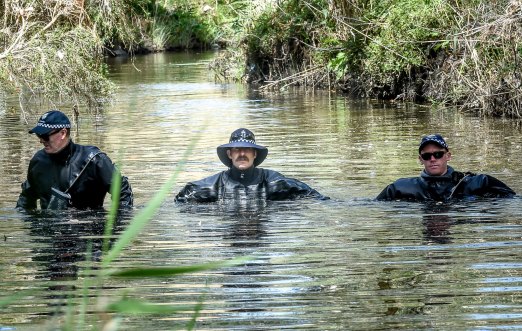‘I’m not leaving here until we find her’: The dogged police hunt for a murder victim’s body
Save articles for later
Add articles to your saved list and come back to them any time.
Detective Senior Constable Samantha Russell, dressed in a pure white forensic suit in contrast to the wet, stinking rubbish dump she is searching, stops to confirm what she suspects, slumps with her hands on her knees with relief before waving her arms wildly to get the attention of her colleagues. They have found her.
She had been dead for months, murdered by a jealous want-to-be boyfriend, but for missing persons squad investigators arresting the offender is secondary to finding the victim.
Detectives Samantha Russell and Tony Combridge.Credit: Chris Hopkins
The head of the squad, Detective Acting Inspector Tony Combridge says, “Our priority is to return the victim to their family.”
One reason he says is that no matter the evidence, families will hold onto a shred of belief that the missing will defy the odds and be found alive. “One of our jobs is to extinguish that last piece of hope, so they can grieve properly.”
In the case of Ju “Kelly” Zhang, police knew what had happened, had arrested the offender and were confident they had the evidence to convict. But they were not going to stop until they found her.
Police budgeted to spend $1 million in a 12-week search of a 40-metre deep, 300-metre by 200-metre channel in the giant Wollert tip. But this was no needle in the haystack job – with the help of the refuse management experts onsite and GPS and altitude monitors on the collection trucks, they had pinpointed the near exact area. They found the victim in four days.
Kelly Zhang, killer Joon Seong Tan and the search.Credit:
At first dozens of police raked through scoops dug up by the excavator. Then the operator began to use his digger as a sifter, gently shaking each scoop like a gold prospector in a river.
Kelly Zhang, 33, was stabbed to death in her Epping home on February 1, 2021, with her eight-year-old son, Jack, in the next room.
Joon Seong Tan had met Zhang through an online dating site only one month earlier and killed her when she wished to move on.
The following day he declared her missing, claiming she had walked out the front door in her pink dressing gown and disappeared. “The locals [police] were not happy with the story and came to us [missing persons] on the fourth,” says lead investigator Sam Russell.
Police search the Wollert tip.Credit: Nine News
Russell is everything you want to see in a modern cop. Smart, dedicated and committed to her job and the victims she represents. The former emergency nurse took to policing in 2011 and soon knew she wanted to work on complex cases such as Zhang’s. Ten years later she won the Mick Miller Detective of the Year Award for her work in this case. “I’ve told her I’ll be working for her one day,” says Combridge, her squad boss.
Identifying the prime suspect was not the challenge. Tan had lied about Zhang’s disappearance and then behaved as someone hiding a guilty secret.
“Within days he was trying to hide. He changed his phone number, hid at a female friend’s house and had left his car at a reserve. He was arrested on Sunday, the 7th, in a Doncaster street waiting to be picked up and driven to Perth,” says Russell. He was carrying $3500 and his passport.
When he was interviewed, they didn’t have enough, but within two days they would.
His phone showed that the day before he was brought in for questioning he had conducted online searches including, “How many years for killing a person in Australia?″; “How is stinky garbage disposed of in Australia?” and “Garbage disposal in Australia”.
On February 10, nine days after the murder, he was arrested at Melbourne Airport about to fly to Perth (without his passport, which had been seized by police), where he planned to find a boat to return to Malaysia.
Zhang’s parents flew in from mainland China, hoping their daughter was alive, perhaps kidnapped and held captive in a warehouse. They checked the letter box every day hoping for a ransom demand. Despite having spent their life savings, they were determined to pay. It was Russell’s job to care for them and manage their expectations while gathering evidence on Tan and finding Zhang’s body.
Using statements and electronic evidence, Russell concluded Tan disposed of Zhang in the Heidelberg area. Police searched parks, reserves and local creeks, and also checked dozens of industrial bins. They came up empty.
Police searching an area of bushland and Darebin Creek west of Sheehan Road in Heidelberg West. Credit: Justin McManus
Later police would find that on the night of the murder Tan drove through Heidelberg and saw it was bin night. He drove back to Zhang’s house, where he had hidden her in a cupboard, wrapped her in a blanket, then put her body in her own rubbish wheelie bin and took it to Heidelberg to be collected.
The following morning he grabbed the empty bin, took it back to Zhang’s Epping home and cleaned it.
After breaking Tan’s friend’s alibi, Russell worked out what had happened, concluding the bin would have been collected and its contents dumped in the Wollert tip. Months had elapsed when Combridge made his pitch to his bosses: we need up to $1 million to find her. He was asked how confident he was that they would find the body. He put his reputation on the line, saying he was 85 per cent sure, and those who signed the cheques liked the odds.
“We were told, ‘If it needs to be spent, spend it’,” Combridge says. (They ended up spending only $36,000.)
Wollert tip trench.
We should all pause here. The offender was in custody, a conviction was likely, and the family would hear in public court what happened. Yet, the search was authorised. There are few jurisdictions in the world where an operation like this would have been conducted, and as long as we are prepared to respect the dead and care for the living in this way we remain a civilised society.
A massive 250,000 tonnes of refuse had been deposited since Zhang disappeared, but this time luck was on the investigators’ side. The day after she was murdered, the tip operators moved to a new channel to dump rubbish
From here it was the tip workers rather than investigators who took the lead. Using GPS readings, they identified the specific area in the giant channel. So, rather than looking for a needle in a haystack they were looking for a needle in a hay bale.
When Russell arrived at the tip, she had one thought: “I’m not leaving here until we find her.”
After four days of searching the tip, workers told police they were close and thought they would find her in a few days. “Forty-five minutes later she was found,” says Combridge.
Russell was standing near the excavator. “Steve [Anderson] operated it like a third hand, gently lifting scoops. He said he was thinking with every scoop, ‘Please be her,’ ” she says.
She looked in the hole and saw something wrapped in a blanket. “I called out to Steve, ‘I think I can see her hand.’
“He gently scooped her up and put her down next to me. Then I could see her blue stripey pyjamas and pink dressing gown.”
Russell said she felt a wave of emotions. “There was happiness, shock, and I was sad she had been left in that environment.”
It was, she says, “pissing rain”. The detective, perhaps instinctively, used a tarp to protect the victim.
But she didn’t have time to dwell. Once back at the office, she and Combridge headed out to tell the family before the news broke of the discovery.
They spoke to the eight-year-old Jack – the only family member who spoke English. They told him they had looked for his mother. He asked, “Is she alive?” The answer was no.
“He was devastated,” says Combridge.
As were the parents, but there was another emotion – relief. “It is hard to reconcile how grateful they were that we had found her.”
Detective Samantha Russell outside the Supreme Court.Credit: Justin McManus
Tan was convicted of murder, sentenced to a minimum of 23 years and will face deportation at the end of his sentence.
Justice Amanda Fox praised Russell for her thorough investigation. At the sentencing, the tip team who worked with police were there, all dressed in pink, Zhang’s favourite colour.
“They were brilliant. I didn’t know when this started that I would end up making friends with the 70-year-old tip manager,” says Russell.
Harry Taylor did much of the heavy lifting, helping find the spot where Zhang was left and, with another worker and two police, carrying her body out in knee-deep mud.
Taylor’s victim impact statement illustrated perfectly the commitment shown by the police and the Wollert workers.
“Although I never met Ms Zhang when she was alive, it seemed to me, in a strange way, that she and I, who had never met, were on a journey together. I attended her funeral at Springvale, contributed to the limits of my capacity in an appeal to support her destitute parents. My wife and I put together and delivered a hamper for her mum and dad and Jack for Christmas. On behalf of all the landfill team, Kelly, we did our best for you, and it turned out that our best was good enough.”
Coming soon: Naked City (the book) via Pan Macmillan. A selection of John Silvester’s least worst columns.
Most Viewed in National
From our partners
Source: Read Full Article









